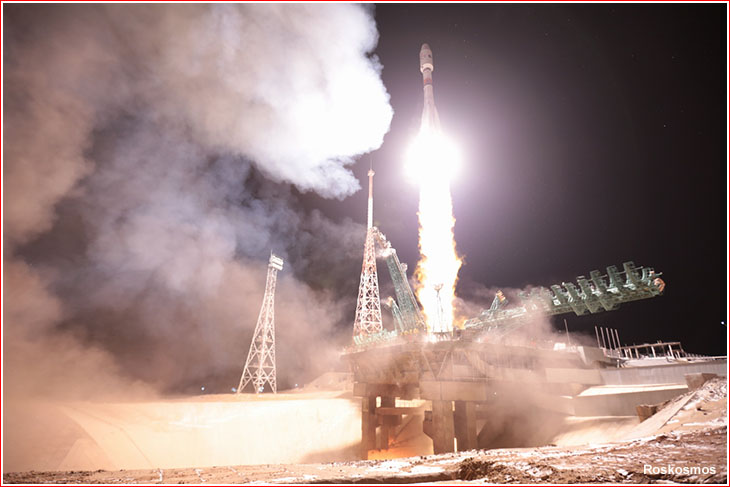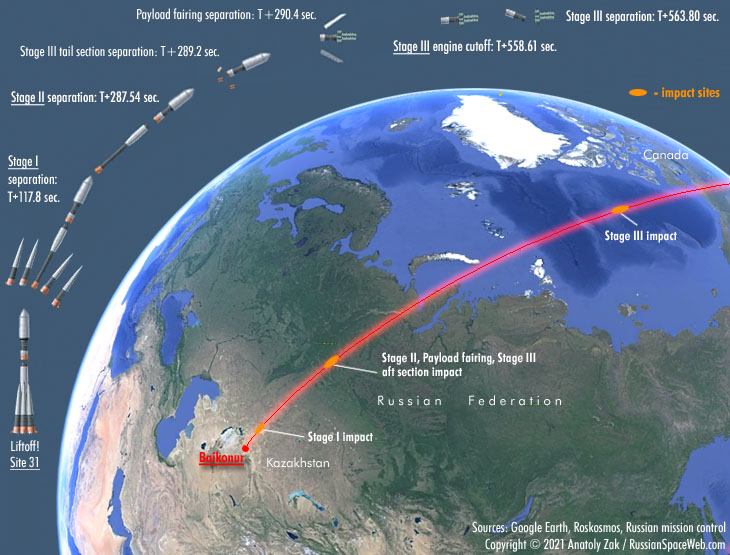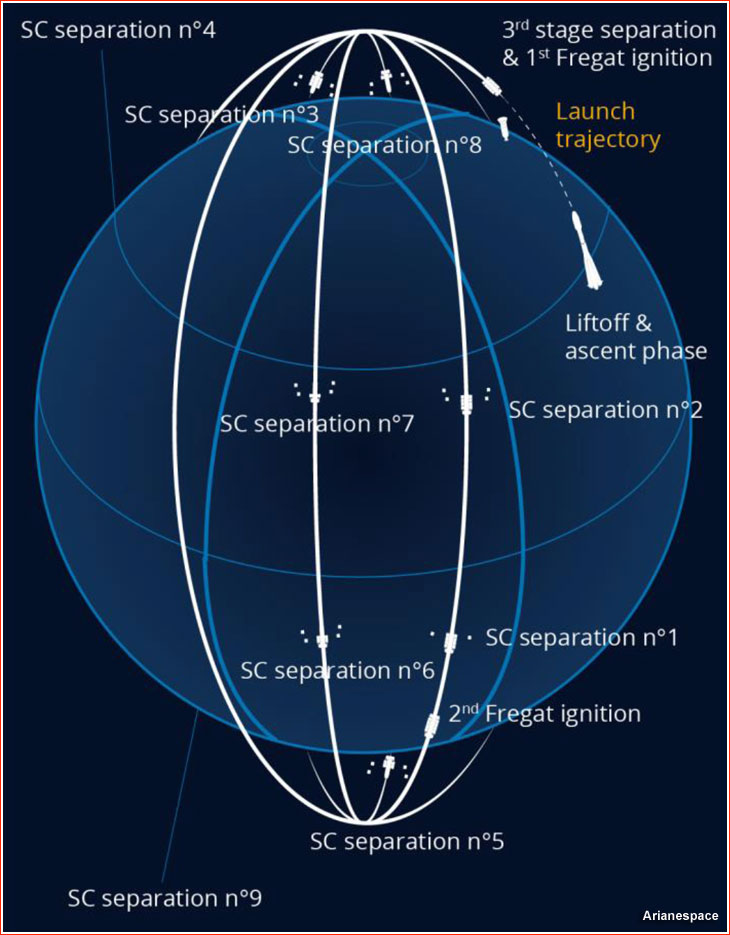Soyuz launches the 12th OneWeb cluster (original) (raw)
Soyuz launches the 12th OneWeb cluster
A Soyuz rocket family completed its 22 launch campaigns of 2021 with the delivery of 36 satellites for the UK-based OneWeb company. The mission lifted off from Baikonur Cosmodrome in Kazakhstan on December 27. It was the 12th mission for the OneWeb overall and the eighth launch of the year to build the Internet constellation, expanding it from 358 to 394 spacecraft.
Previous OneWeb launch: ST36

The 12th Soyuz mission with OneWeb satellites at a glance:
| Mission and spacecraft designation | ST37 OneWeb (Satellites 359-394) |
|---|---|
| Launch vehicle | Soyuz 2-1b / Fregat No. 123-04 |
| Payload fairing | 81KS |
| Launch site | Baikonur, Site 31 |
| Launch date and time | 2021 Dec. 27, 16:10:37.088 Moscow Time |
| Payload mass (including dispenser) | 36 OneWeb satellites, 5,510 kilograms total |
| Target orbit | Altitude: ~450 kilometers, inclination 87.4 degrees* |
*Satellites will use their own propulsion system to enter a 1,200-kilometer operational orbit
Preparations for launch
On Sept. 17, 2021, two payload dispensers for upcoming OneWeb missions, including one for December launch, along with ground support equipment, had landed in Baikonur aboard an Il-76 transport plane.
On September 23, Roskosmos said that two Soyuz-ST rockets were shipped to French Guiana and confirmed that the launch of OneWeb satellites had been planned for December.
Following the 11th OneWeb launch, the company's representative confirmed that there had been no launch site availability for the next mission until December.
On November 2, Roskosmos said that launch campaign for the mission started in Baikonur with setting up connections of the Fregat upper stage to its diagnostic equipment followed by pneumatic and electric tests performed by specialists from NPO Lavochkin and the Yuzhny branch of Roskosmos' TsENKI ground infrastructure division.
On Nov. 9, 2021, NPO Lavochkin rolled out a trio of Fregat upper stages, two of which were intended for upcoming OneWeb missions. They were shipped to Baikonur by rail.
On Nov. 30, 2021, an An-124 transport plane landed at Krainy airfield in Baikonur delivering OneWeb satellites for the mission. They were then transported to processing facility at Site 112.
On December 7, Roskosmos announced that the launch vehicle and the payload fairing had arrived in Baikonur. The rocket components were delivered to a work station at Site 31, while payload fairing was brought to Site 112 (where satellites were processed for launch). The active processing of the rocket for launch was scheduled to begin on December 9, Roskosmos said. The assembly of the payload section for the mission was completed on December 17.
Launch profile of the OneWeb mission originating from Baikonur

A Soyuz-2-1b rocket with a Fregat-M upper stage and carrying a cluster of 34 OneWeb satellites lifted offas scheduled from Site 31 in Baikonur on Dec. 27, 2021, at 16:10:37.088 Moscow Time (8:10 a.m. EST).
After a few seconds of vertical ascent, the launch vehicle headed northward, across Kazakhstan and Russia to align its ascent trajectory with a near-polar orbit inclined 87.4 degrees toward the plane of the Equator.
The four boosters of the first stage should separated T+117.8 seconds after liftoff, but the core booster of the second stage continued firing until 287.5 into the flight. It separated moments after the ignition of the third stage. Less than two seconds later (T+289.2 seconds), the tail section of the third stage split into three segments and separated as well. Another second later (T+290.4 seconds), the payload fairing, which protected the payload in the dense atmosphere, split in the two fragments and fell off.
The third stage completed its firing and separated at T+561.9 seconds, releasing the Fregat upper stage and its cargo on a ballistic trajectory just short of orbital velocity. It allowed the third stage to reenter and fall into a projected area of the Arctic Ocean, north of the Canadian coast.
Exactly one minute after the separation from the third stage, the Fregat was programmed to fire its main engine for 4 minutes and 11 seconds entering a transfer elliptical (egg-shaped) orbit with the lowest point (perigee) 140 kilometers above the Earth's surface and the highest point (apogee) 425 kilometers, which is near the target altitude for the release of OneWeb satellites.
Roskosmos comfirmed that the Fregat had initiated its firing, but the vehicle then left the communications range of Russian ground stations and was not expected to re-eastablish communications until 17:44 Moscow Time (9:44 a.m. EST).
Upper stage maneuvers

After its first maneuver, the Fregat climbed passively for nearly an hour. Upon reaching the apogee of the transfer trajectory, Fregat re-ignited its engine for 34 seconds making its orbit circular at an altitude of around 450 kilometers.
Then, 1 hour 11 minutes and 40 seconds after launch, the first quartet of OneWeb satellites was released in opposite directions from their dispenser attached to Fregat.
In the following 15 minutes, Fregat made a 15-second burn with its small attitude control thrusters to get in position for another release around three minutes later, of the second satellite quartet.
Upon reentry of the vehicle into the communications range during the second orbit of the mission, ground control confirmed that two quartets of satellites had been successfully released.
The Fregat was programmed to repeat its thruster firing and release routine seven more times, evenly distributing the quartets of satellites along their orbit. The final four of 36 passengers were scheduled to be off their space tug 3 hours and 45 minutes after their liftoff from Baikonur.
The separation of the third quartet was confirmed around half an hour after the second and during the third orbit of the mission, all 36 satellites were confirmed as sucessfully released.
Around 1 hour and 20 minutes after the release of the final quartet, the Fregat was programmed to initiate a braking maneuver which is designed to push the stage on a disposal orbit, resulting in its quick destruction in the upper atmosphere nearly six hours after launch. NPO Lavochkin, the Fregat developer, had confirmed that the stage had been successfully deorbited over a remote area of the Atlantic Ocean.
Following their release, the satellites normally maneuver to their operational orbits 1,200 kilometers above the Earth's surface, using onboard electric thrusters.
Next OneWeb launch: ST37
Page author: Anatoly Zak; Last update:February 10, 2022
Page editor: Alain Chabot; Last edit: September 14, 2021
All rights reserved
